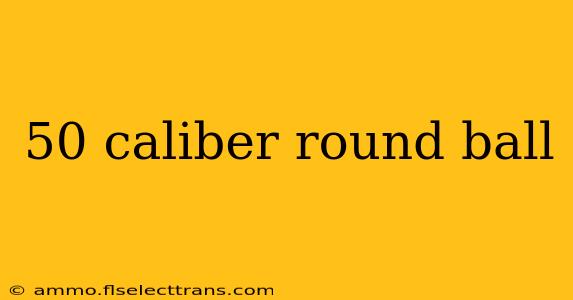The term "50 caliber round ball" evokes images of powerful muzzleloading rifles, echoing through history with tales of frontiersmen, warfare, and hunting. But what exactly is a 50 caliber round ball, and what's its significance today? This article delves into the history, uses, and surprising modern applications of this classic projectile.
Understanding the 50 Caliber Round Ball
A 50 caliber round ball is a spherical projectile with a diameter of approximately 0.5 inches (12.7 mm). The "caliber" refers to the diameter of the bore (the inside of the barrel) of the firearm it's designed for. These balls were—and are—typically made of lead, though other metals have been used historically. Their simplicity belies their effectiveness as a devastating projectile, especially at close to medium ranges.
A Deep Dive into History
The use of round balls in firearms dates back centuries, with 50 caliber being a popular size for larger, more powerful rifles. These weapons played a critical role in:
- Early American Frontier: 50 caliber rifles were essential tools for pioneers, hunters, and soldiers alike. Their accuracy and stopping power were invaluable in a harsh and often dangerous environment. The legendary "Kentucky Rifle," for instance, often fired a .50 caliber round ball.
- Civil War Era: While rifled muskets were becoming more common, smoothbore muskets firing round balls remained in use during the American Civil War, particularly in situations where rapid fire was prioritized over long-range accuracy.
- Global Conflicts: Variations of the 50 caliber round ball found use in various conflicts throughout history, demonstrating the enduring design's adaptability.
Evolution and Variations
While the basic design remained consistent, subtle variations emerged over time. Different lead alloys were employed, impacting the ball's density and performance. Additionally, variations in manufacturing techniques influenced the overall consistency and accuracy of the projectiles.
Modern Applications and Relevance
Despite the rise of more sophisticated projectiles, the 50 caliber round ball maintains a niche presence in modern times. It's popular among:
- Black Powder Enthusiasts: Many historical reenactors and black powder shooting enthusiasts utilize 50 caliber round balls for their historical accuracy and the experience of using traditional firearms.
- Muzzleloading Hunting: While not as common as other projectiles, some hunters still employ round balls for hunting larger game, particularly at close range. The significant stopping power of the 50 caliber round ball makes it effective for such purposes.
- Casting and Hobbyists: The process of casting your own lead round balls is a popular hobby for some, combining historical interest with practical skills.
Accuracy and Ballistics
It's crucial to understand that the accuracy of a 50 caliber round ball is inherently limited compared to modern, rifled projectiles. The smoothbore barrels these balls were designed for lacked the rifling (grooves) that spin the projectile, improving stability and accuracy at longer ranges. Accuracy is significantly affected by factors like wind, distance, and the quality of the firearm and the projectile itself.
Conclusion
The 50 caliber round ball, though seemingly simple, represents a significant piece of firearms history. From its role in shaping the American frontier to its continued presence in modern hobbies, its legacy endures. While its practical applications may be niche today, understanding its history and characteristics provides a valuable insight into the evolution of firearms technology and the enduring appeal of traditional shooting.

